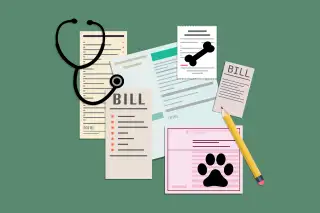3 Ways You'll Still Pay at the Vet Even if You Have Pet Insurance

Like most other insurance, health coverage for your pet offers peace of mind against the worst happening. But it won't entirely remove the burden of paying for your pet's medical care. You'll still be on the hook for several obligations, beyond what you pay in premiums on the policy.
Pet insurance typically comes with a thicket of coverage exclusions -- like preventive procedures being excluded from the most popular policies, or most pre-existing conditions not being covered. But even if a vet visit is covered, the policy's provisions will limit how much, and how, much of the cost is paid, with you required to pay the rest, at least for a time.
Those realities don't mean pet insurance isn't worth getting, necessarily. But it does mean that if you have a policy -- or are thinking about getting one -- it pays to be mindful of these payment requirements.
You'll be responsible for a deductible and co-pay
As with much other insurance you carry, pet policies make pet owners responsible for paying a deductible -- in an amount you select -- before the policy’s coverage kicks in every year. You also choose the co-pay -- the percentage that will be reimbursed to you on every bill submitted after you have met the deductible.
When we surveyed pet insurance costs last year, the amount of the deductible you chose had a bigger effect on the cost of your policy than almost any other option. Choosing a $500 deductible rather than one of $200, a typical low-deductible option, saves dog and cat owners an average of about $216 a year in premiums, we found. And doubling the deductible again more than doubles the savings, to about $450 a year.
A further limitation may be buried in the fine print, warns Beth Wymer, an insurance expert with Pumpkin Pet Insurance. "Some companies have a 'per condition' deductible, which means that every time a pet goes to the vet for a new issue, owners have to hit a new deductible before payment reimbursement kicks in.”
Reducing the percentage of expenses the policy reimburses (up to the annual limit) can also cut your premiums. In our survey, we found a typical policy for a dog , with a $500 deductible with a $5,000 a year treatment limit, cost $100 a year less in premiums if you chose to have only 70% of medical costs reimbursed, rather than the maximum of 90%.
Deciding on an annual deductible obviously requires weighing what you could afford to pay at one time in the event of a costly visit to the pet against what you’d pay in higher premiums over the course of a year.
For her part, Wymer urges people to err on the side of greater coverage. "While pet owners tend to be drawn to the cheaper options for plans," Wymer says, "it’s important to know that such options usually have larger gaps in coverage and therefore may not be as cost-effective over time."
You might exceed the policy's payment limits
Your own health insurance wouldn’t cut off coverage for cancer treatment because it had become too costly, or for an expensive procedure that recurred year after year -- but a pet policy could.
Pet insurance plans can limit the total cost of coverage in up to three ways. Payouts can be capped for a particular condition; in any one year; and over the pet’s lifetime. (Some insurers do offer plans that have no such limits.)
These limits all typically begin in the low- to mid- thousands, and rise into the tens of thousands if you so choose. As a rule, a lower limit will suffice if your animal has a normal medical life. The American Pet Products Association reports that dog owners spend an average of $628 a year on vet visits, and cat owners $364, and those figures include preventive procedures that the most popular policy types don’t cover.
But a serious condition, such as cancer or kidney disease, can send costs soaring to $5,000 1or more in a single year. The impact of raising annual limits is relatively modest compared with other changes to policies. When we surveyed premiums for both dogs and cats across five pet insurers, doubling the annual coverage limit from $5,000 to $10,000 boosted premiums by an average of about $5 a month.
"When deciding on a pet insurance plan, it’s best to choose one with a higher annual limit to protect you in case of a large unexpected event,” recommends Wymer. “If an owner has a lower annual limit like $5,000 and a procedure costs $10,000, the pet owner would be responsible for covering the difference out of pocket. That’s one of the biggest regrets that people have when they choose a lower-annual-limit plan."
You'll (probably) have to pay bills upfront
Your own health insurance likely allows you pay only your own co-pay amount after a visit, and sometimes even that is levied later, after the doctor and your insurance company have settled up.
Alas, that isn’t how things typically work with pet insurance. Vets usually don’t “take insurance” in the same ways doctors do. Instead, you’re usually responsible for paying vets’ bills upfront and then submitting the paperwork and waiting for reimbursement to be sent to you.
The promised times to process claims varies; several companies pledge to do so within 30 days, others say they “try hard” for 10-day completion, and others still focus on beginning the processing within a certain time -- typically 24 hours.
More from Money
10 Best Pet Insurance Companies of 2021
Cats vs. Dogs? When It Comes to Premiums, There's a Clear Winner
The Ultimate Guide to Pet Insurance Costs: How Prices Vary by Breed, and Tips to Help You Save